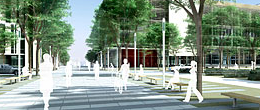Description and history
The Department of Chemistry at UdeM is one of the leading academic units in Canada. It enjoys an international reputation thanks to the outstanding quality of its research, faculty and infrastructure.
A number of the Department's professors also teach and conduct research in chemistry-related disciplines in the departments of Biological Science, Biochemistry and Physics, as well as in the Faculty of Pharmacy and at Polytechnique Montréal, one of the top engineering schools in Canada.
Several faculty members hold prestigious chairs and fellowships in recognition of the quality of their work. Others head up research groups or direct analytical services offered at the University. The Department's professors are experts in a variety of fields that contribute to advancing knowledge.
The Department of Chemistry has:
- Nearly 35 professors
- Over 50 postdoctoral fellows
- Over 400 students at the bachelor's, master's and doctoral levels
- Approximately 70 courses offered every year
- Some 80 graduates every year
History of the Department of Chemistry
Creation of the Université de Montréal, the Faculty of Science and the Department of Chemistry
In February 1920, UdeM became a distinct legal entity when it separated from Université Laval. That same year, the Faculty of Science was born at UdeM. It included the Department of Chemistry-Medicine, directed by Father L. J. Morin.
The degrees granted, based on the French model, ranged from licences to PhDs, attestations and graduate certificates, and PCN (physics, chemistry and natural science) certificates.
In 1942, the Faculty of Science opened new premises on Mont-Royal Avenue. Now at 2973 m2, this was considerably more spacious than the previous facilities. Well-equipped classrooms and laboratories made for a much improved learning environment for science students.
The 1950s and 1960s were marked by a quest for freedom and modernization. The Department gained more autonomy from the Faculty of Medicine and fully adopted North American university standards. The faculty also enjoyed more stability, and this spurred the development of basic research programs. In 1958, it became known as the Department of Chemistry, the name it still bears today.
In 1972, the Faculty of Science joined the vast Faculty of Arts and Science. The Department's growth phase now gave way to consolidation and greater flexibility in teaching.
Today the Department of Chemistry occupies some 6810 m2 on the Mount-Royal Campus (Roger-Gaudry and J.-Armand-Bombardier buildings). The future Outremont Site, to house the new UdeM Science building by 2018, will be home to 6 departments, including the Department of Chemistry and 2 research centres.
History and development of programs and studies
Right from the early days, students in the Faculty of Science were trained for graduate certificates and the licence in science. The original mandate also provided for a PhD in science.
In order to expand the range of certificates offered, it was decided in 1921 to establish a Chair in Physical Chemistry. This accompanied the creation of the Certificate in Applied Chemistry, later rebaptized the Certificate in Analytical Chemistry. The very1st doctoral cohort received their diplomas in 1922 after defending their dissertations. In January 1933, the Council of the Faculty of Science modified its graduate programs and created a master's degree.
The Faculty and its development
The Department of Chemistry initially had 3 professors: Father L. J. Morin, Dr. Baril and Hervé Nadeau. With the creation of certificates in physical chemistry, they were joined by lecturers Jean Flahaut and Paul Riou. In 1943, Rachel Robert became the 1st female professor in the Department.
In these early years, the many different functions demanded of the teaching staff made it difficult to create a career faculty whose members could devote themselves full-time to the Department. Scientific and professional activities were spread out among various departments, faculties and schools. In the 1950s and 1960s, a period of emancipation and expansion, most of the lecturers were replaced by full-time career professors.
The growth of research
In the Department's first 20 years, its facilities were ill equipped for research. With the exception of Brother Marie-Victorin, the founding professors of the Faculty and the Department had not chosen research careers, although they were devoted and well trained for their time.
Messrs Riou, Barré and Labarre, who were both chemists and pharmacists, and Mr. Lortie were the first professors to hold PhDs, and so were more interested in research.
Professor Barré's team began its work with Lucien Piché's thesis, in 1940. By that point conditions had improved enough that serious research had become possible. By 1945, more than 12 researchers were studying topical questions.
With the formation of a full-time career faculty, the research aspect of the Department's operations exploded, figuratively speaking, making it one of the leading centres for chemistry research in Canada.
The Department was founded by organic chemists and still maintains this tradition, with much of its research focused on organic molecules. Physical chemistry, spectroscopy and theoretical chemistry represent a large portion of the Department's research efforts, along with analytical chemistry, X-ray diffraction and inorganic chemistry.
